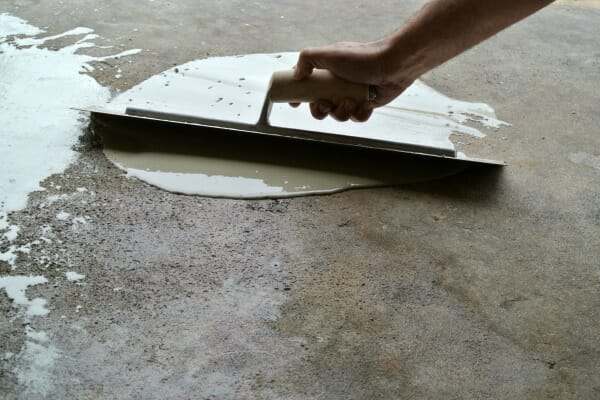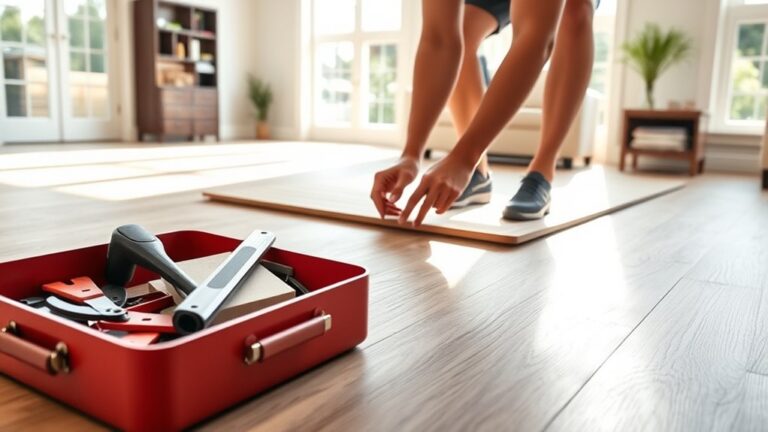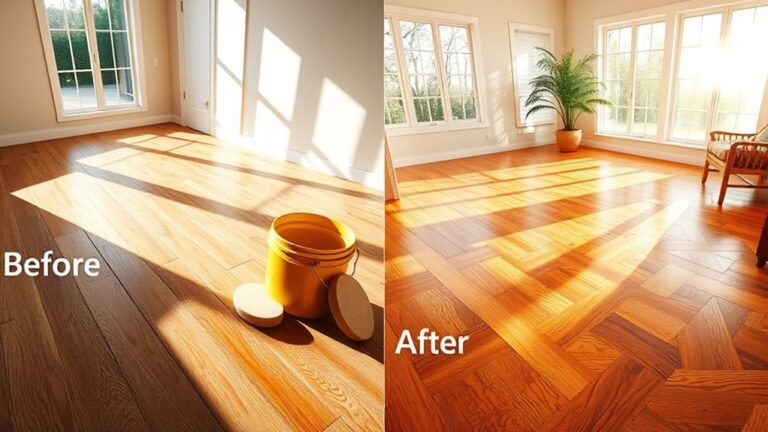Repair pitted garage floor by using a concrete resurfacer and following these steps. Is your garage floor riddled with pits and holes?
Don’t worry, there’s a simple solution. Over time, garage floors can become pitted due to wear and tear, chemical spills, or other factors. These pits not only affect the appearance of your garage but also pose a safety hazard. Fortunately, you can restore your garage floor to its original smooth surface by using a concrete resurfacer.
This cost-effective solution allows you to fill in the pits and achieve a level and durable finish. We will guide you through the process of repairing a pitted garage floor and provide tips for a successful outcome.
Understanding Pitted Garage Floors
Discover effective solutions for repairing pitted garage floors and transform your space. Learn how to restore the surface to its original condition with step-by-step tips and expert advice.
Pitted garage floors are a common issue homeowners face, resulting in a rough and damaged surface. These imperfections can be caused by various factors, such as wear and tear over time, harsh chemicals, and heavy vehicle usage.
A pitted garage floor refers to the presence of small holes, depressions, or craters on the surface. These pits can range in size, depth, and severity, depending on the underlying causes.
Pitted garage floors can be caused by several factors, including:
- Freeze and thaw cycles, particularly in regions with harsh winters
- Chemical spills, such as oil, gasoline, or solvents
- Excessive moisture or water seepage
- Improper installation or poor-quality concrete
Repairing pitted garage floors is essential for various reasons:
- Pits can accumulate dirt, making it challenging to clean the surface
- Uneven surfaces increase the risk of tripping or falling
- Enhances the appearance of your garage
- Prevents further damage and extends the lifespan of the concrete
Assessing The Damage
Assessing the Damage:
To repair pitted garage floors, the first step is to assess the extent of the damage. This involves identifying the severity of the pitting and determining the tools and equipment needed for assessment. During the assessment process, it is important to document and measure the damage accurately.
Identifying the severity of pitted garage floors:
Identifying the severity of the pitting helps in understanding the level of repair required. It can range from minor surface imperfections to deep and extensive pitting. By carefully inspecting the floor, you can determine the appropriate course of action.
Tools and equipment needed for assessment:
To assess the pitted garage floor, you will need certain tools and equipment. These may include a flashlight or bright lighting to better examine the surface, a tape measure or ruler to measure the depth and width of the pits, and a camera or smartphone to document the damage for reference.
Documenting and measuring the damage:
As you assess the damage, make sure to take clear photographs or videos of the pitted areas. This documentation will help you keep track of the affected areas and serve as a reference during the repair process. Additionally, measure the size and depth of the pits to determine the best repair method and estimate the needed materials.
Choosing The Right Repair Method
When repairing a pitted garage floor, it’s important to choose the right repair method for effective and long-lasting results. There are several different repair methods available, each with its own pros and cons.
| Repair Method | Pros | Cons |
|---|---|---|
| Epoxy Coating | Durable and long-lasting Provides a smooth and seamless finish | Requires extensive surface preparation Can be expensive |
| Concrete Resurfacer | Easy to apply Cost-effective option | Not as durable as epoxy coating May require regular reapplication |
| Concrete Overlay | Provides a fresh and new appearance Can be customized with various designs | Requires professional installation May not be suitable for heavily damaged floors |
When selecting a repair method for your pitted garage floor, there are a few factors to consider. The extent of the damage, your budget, and the desired outcome should all be taken into account. Additionally, it’s important to assess the level of expertise required for each method and whether you are able to DIY or should hire a professional for the job.
Preparing The Garage Floor
Cleaning and removing debris from the floor: The first step in preparing a pitted garage floor for repair is to clean it thoroughly. Remove any loose dirt, dust, or debris using a broom or vacuum cleaner. Next, use a pressure washer or hose to wash the floor with water. Scrub the surface using a stiff-bristle brush and a mild detergent to remove any stubborn stains or oil spills. Rinse the floor with clean water and allow it to dry completely.
Patching small cracks and holes: Once the floor is clean and dry, it’s time to patch any small cracks and holes. Start by filling the cracks with a concrete patching compound, using a trowel to smooth it out. For larger holes, use a premixed concrete resurfacer. Apply the resurfacer to the hole, making sure to fill it completely. Smooth the surface using a trowel or straightedge. Allow the patching compound or resurfacer to dry according to the manufacturer’s instructions.
Preparing the surface for repair: Before repairing the pitted garage floor, it’s important to ensure that the surface is properly prepared. This involves roughening the floor to create a better bond for the repair material. Use a concrete grinder or a floor sander with a coarse-grit abrasive pad to roughen the surface. Make sure to wear protective gear, such as goggles and a dust mask, when doing this step. Once the surface is roughened, sweep or vacuum away any dust or debris.
Repairing Pitted Garage Floors
Repairing pitted garage floors can be a daunting task, but with the right techniques and materials, you can restore your floor to its former glory.
Filling pitted areas with a leveling compound is the first step in the repair process. Choose a compound that is specifically designed for garage floors and follow the manufacturer’s instructions for application. Make sure to smooth out the compound evenly to create a level surface.
Applying epoxy coatings is the next step for achieving a smooth finish. Epoxy coatings not only provide a durable and attractive finish, but they also help to protect the floor from future damage. Choose an epoxy coating that is compatible with the leveling compound and apply it according to the manufacturer’s instructions.
After the epoxy coating has dried, sanding and buffing the repaired floor can help to further improve its appearance. Use a sanding machine or hand sanding tools to smooth out any rough areas and then use a buffer to enhance the shine of the floor.
Preventative Maintenance
To prevent future pitting on your garage floor, regular cleaning and maintenance routines are essential. Make sure to sweep or vacuum the floor regularly to remove dirt and debris that can cause wear and tear. Additionally, clean up any spills or stains as soon as possible to prevent them from penetrating the concrete and causing damage. Another preventive measure is to apply sealants and protective coatings on the floor. These products act as a barrier against moisture, chemicals, and other substances that can lead to pitting. When applying sealants, carefully follow the manufacturer’s instructions and allow sufficient drying time for maximum effectiveness. Consider reapplying sealants every few years to maintain the protective layer. By incorporating these simple preventative maintenance tips into your routine, you can keep your garage floor looking smooth and free from pitting.
Enhancing The Appearance Of Your Garage
Enhancing the appearance of your garage can be done through various methods. One way is by adding a decorative epoxy coating to your pitted garage floor.
A decorative epoxy coating not only helps to hide the unsightly pits and cracks on your garage floor, but it also adds a touch of style to your space. You can choose from a wide range of colors and patterns to create a unique and personalized look.
Another option to consider is installing mats or tiles on your garage floor. This not only protects the floor from further damage but also enhances its appearance. Mats and tiles are available in various designs, colors, and materials, allowing you to choose one that suits your style and needs.
By taking these steps, you can easily repair your pitted garage floor and give it a fresh and appealing look.

Extending The Lifespan Of Repaired Floors
To maintain the longevity of a repaired garage floor, it is crucial to clean and maintain it regularly. Cleaning the floor plays a pivotal role in preventing further damage and pitting. Start by sweeping away any debris and dirt, then use a pressure washer or a good-quality floor cleaner to thoroughly clean the surface. Scrubbing the floor with a stiff brush will help remove stubborn stains.
Regular inspections are essential to identify any areas that may need touch-up repairs. Check for any signs of cracks or pitting and address them promptly. Applying a concrete patch or epoxy filler to these areas will help prevent further damage and maintain the integrity of the floor.
Reapplying protective coatings, such as sealants or epoxy coatings, periodically is another crucial step. These coatings provide an extra layer of protection against wear and tear, chemicals, and moisture. Follow the manufacturer’s instructions carefully to apply the protective coating properly and ensure its effectiveness in extending the lifespan of your repaired garage floor.
Frequently Asked Questions On How To Repair Pitted Garage Floor
How Do You Fix Pitted Concrete In A Garage?
To fix pitted concrete in a garage, start by cleaning the surface thoroughly. Then, use a patching compound to fill the pits and level the area. Smooth the patched areas with a trowel and allow them to dry. Finally, apply a concrete resurfacer to restore the garage floor’s smooth and even appearance.
Why Is My Garage Floor Pitting?
Pitting on your garage floor can occur due to moisture, chemicals, or wear and tear. It is commonly caused by salt, ice melt, or oil spills, which can erode the concrete surface. Regular cleaning and sealing can help prevent pitting and maintain the floor’s appearance.
Will Epoxy Fill Pitted Concrete?
Yes, epoxy can fill pitted concrete effectively. It is a durable and strong material that can level out irregularities and create a smooth surface. By filling the pits, epoxy also improves the appearance and protects the concrete from further damage.
Can You Paint A Pitted Garage Floor?
Yes, you can paint a pitted garage floor. The paint can help cover up the pits and provide a smoother, more attractive surface. Be sure to clean and prep the floor before painting for best results.
Conclusion
Repairing a pitted garage floor is a task that can be done with the right tools and techniques. By following the steps outlined in this blog post, you can restore the functionality and appearance of your garage floor. Remember to clean, fill, and level the pits before applying a protective coating.
With a little effort and attention to detail, you can enjoy a smooth and durable garage floor for years to come.




